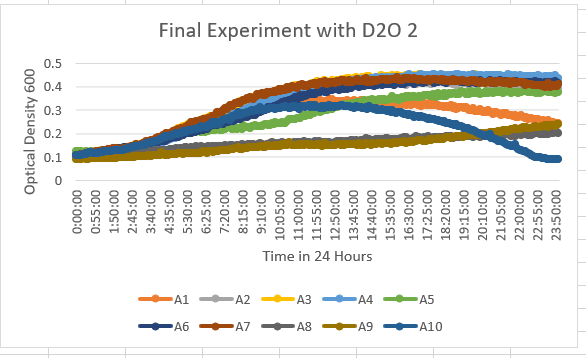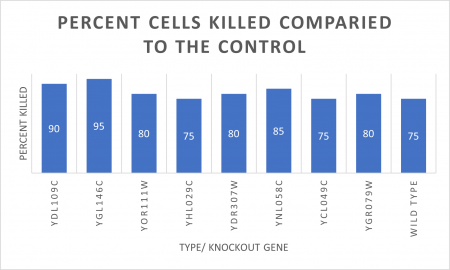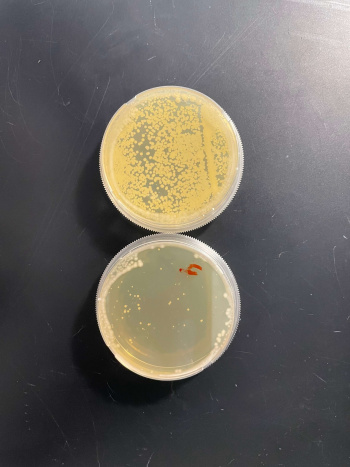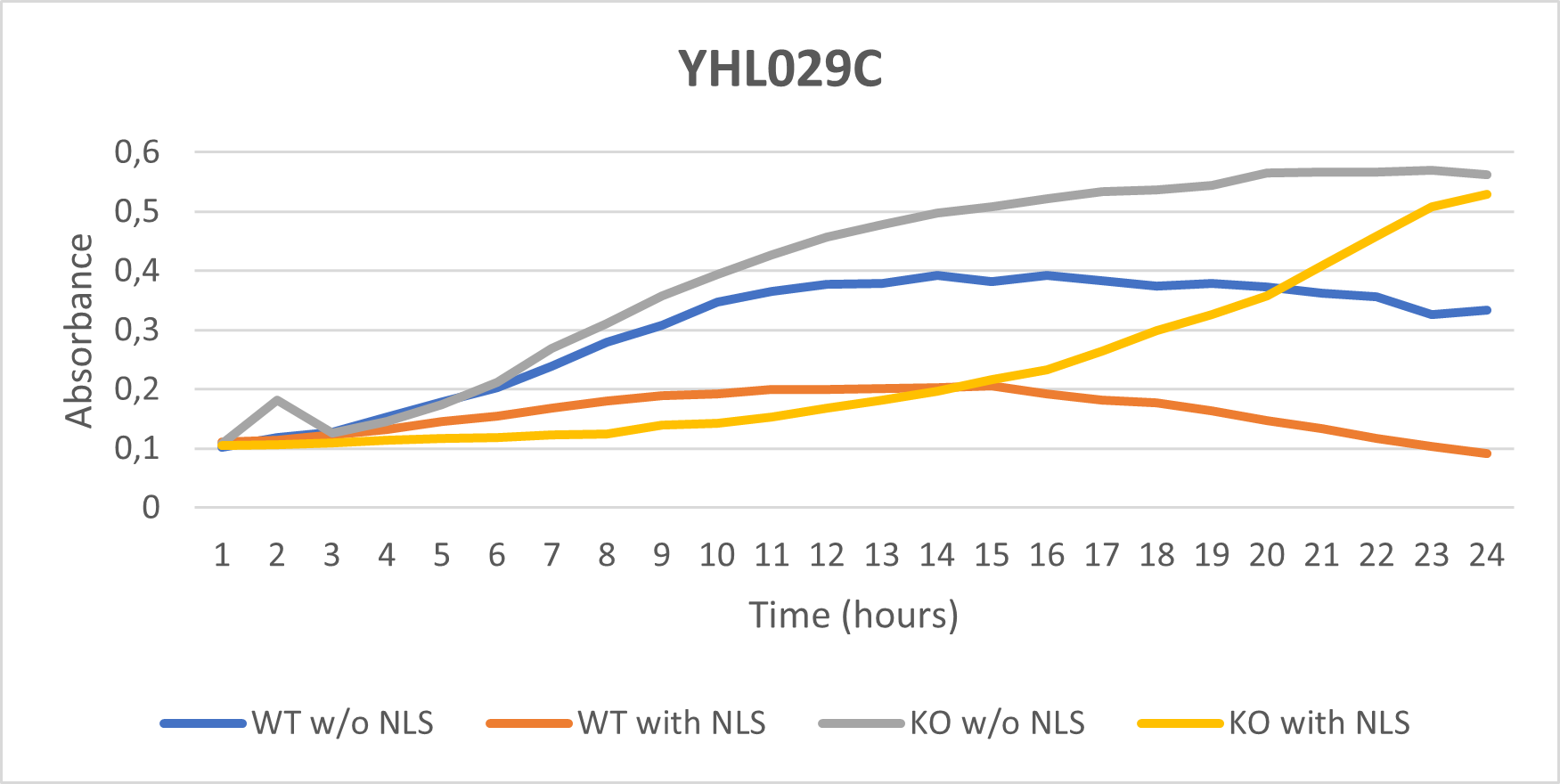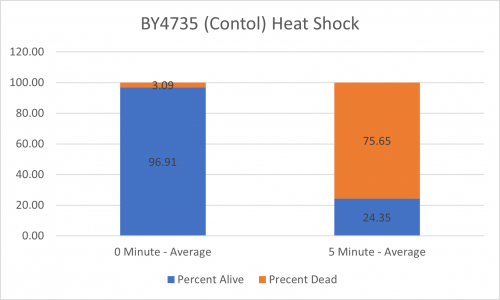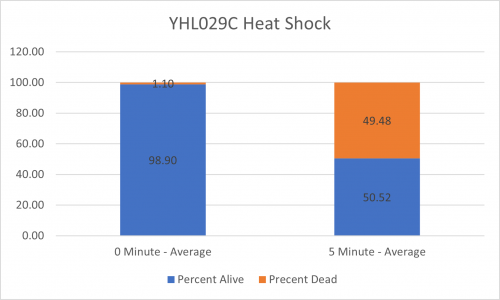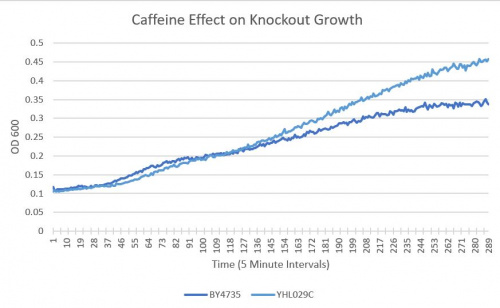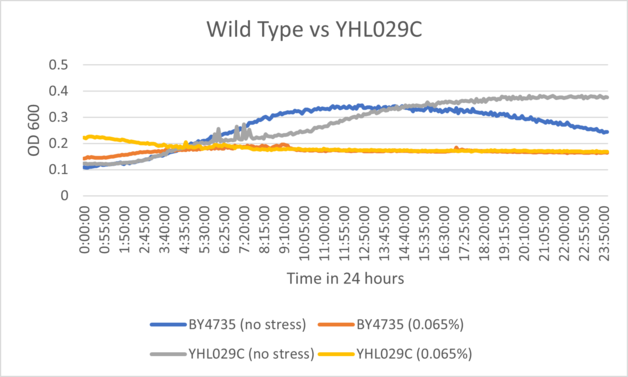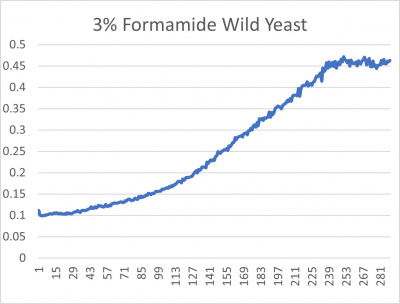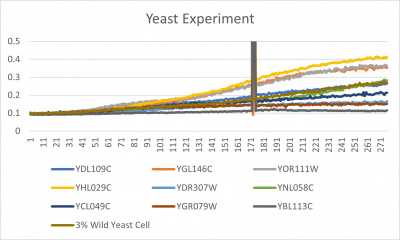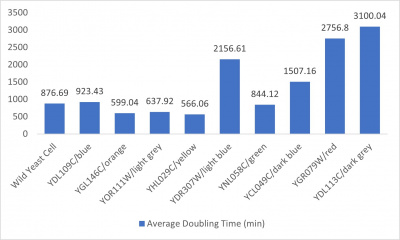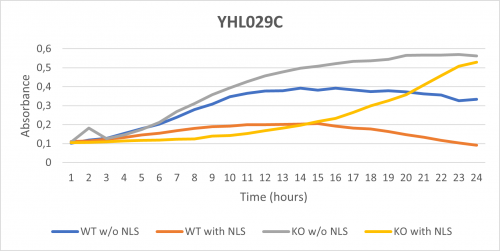Difference between revisions of "YHL029C"
(→UW-Stout/Nystatin SP22) |
(→Community Commentary) |
||
| (6 intermediate revisions by the same user not shown) | |||
| Line 168: | Line 168: | ||
====Results==== | ====Results==== | ||
[[File:YHL-T1.jpg]] | [[File:YHL-T1.jpg]] | ||
| − | [[File: | + | [[File:029C-T2.jpg]] |
| + | From the growth curve, we can see that the YHL029C control grows at a higher rate than the wild type control and experimental, but the treated YHL029C grows at a lower rate than the wild type yeast, meaning that the removal of the YHL029C gene lowers resistance to Nystatin. | ||
| + | |||
| + | |||
| + | ===[[UW-Stout/Formamide SP22]]=== | ||
| + | |||
| + | |||
| + | |||
| + | ===Results=== | ||
| + | [[File:wildyeast.jpg|400px|]] [[File:yeast.jpg|400px|]] [[File:doublingtimestable.jpg|400px|]] | ||
| + | |||
| + | |||
| + | *3% formamide line graph: x-axis= growing time (min); y-axis= optical density 600 | ||
| + | *Trial 2 line graph: x-axis= growing time (min); y-axis= optical density 600; key= yeast strains and corresponding color to the individual lines in the line graph | ||
| + | *Average doubling time bar graph: x-axis= yeast strains and corresponding colors to the trial 2 line graph; y-axis= average doubling time (min) | ||
| + | |||
| + | ===Interpretation=== | ||
| + | The wild yeast cell treated with 3% formamide had a doubling time of 876.69 min. The 3% formamide solution added to nine transformed yeast cells was then compared to the wild yeast cell using the computed doubling times to see the effects of the formamide. In the experiment, some of the transformed yeast cells were heavily effected by the formamide, including the YHL029C strain. The YHL029C strain had doubling times significantly faster than the wild yeast cell, with the fastest doubling time of 566.06 min. It can be concluded that the transformed yeast cell, YHL029C, had a unique response to the formamide stress test used in the experiment. | ||
==References== | ==References== | ||
Latest revision as of 19:35, 11 May 2022
Share your knowledge...Edit this entry! <protect>
| Systematic name | YHL029C |
| Gene name | OCA5 |
| Aliases | |
| Feature type | ORF, Uncharacterized |
| Coordinates | Chr VIII:47968..45929 |
| Primary SGDID | S000001021 |
Description of YHL029C: Cytoplasmic protein required for replication of Brome mosaic virus in S. cerevisiae, which is a model system for studying replication of positive-strand RNA viruses in their natural hosts[1][2]
</protect>
Contents
- 1 Community Commentary
- 2 References
Community Commentary
About Community Commentary. Please share your knowledge!
This gene is part of the UW-Stout Orphan Gene Project. Learn more here.
UW Stout/D2O SP 22
The YHL029C Knock Out Yeast Strain (A4) is unaffected by the 35% dilution D2O . With the maximum optical density of about 0.5-0.6 OD 600.
UW Stout/Sucrose Fermentation SP22
| Gene | Glucose | Fructose | Ethanol |
| Standard solution | 2.0000 | 0.2000 | 2.0000 |
| YDl109C | 0.3800 | 0.3933 | 0.3430 |
| YGL140C | 0.2212 | 0.2685 | 0.1867 |
| YOR111W | 0.3332 | 0.3598 | 0.1343 |
| YHL029C | 0.3870 | 0.2368 | 0.1151 |
| YDR307W | 0.4366 | 0.2487 | 0.0606 |
| YNL058C | 0.2710 | 0.3056 | 0.1577 |
| YCL049C | 0.4078 | 0.3052 | 0.1969 |
| YGR079W | 0.4042 | 0.1589 | 0.0080 |
| YBL113C | 0.3498 | 0.2012 | 0.1434 |
| BY4735 | 0.3171 | 0.3084 | 0.3541 |
Interpretation
This gene produced 32.50% of the amount of ethanol that the wild type produced.
<protect>
UW-Stout/UV Light SP22
As part of the University of Wisconsin Stout Orphan Gene Project this gene was tested under a UV Light using this protocol.
RESULTS
INTERPERTATION
In the graph and photos above, exposing this gene to 600 seconds of 400 Watt UV Light killed approximately 75% of yeast cell cultures, compared to its control counterpart, which was the same gene and amount of cells, just was not exposed to UV Light.
UW-Stout/Heat Shock SP22
As part of the University of Wisconsin Stout Orphan Gene Project this gene was tested by exposing the cells to heat shock.
Results
Interpretation
From the data gathered, there was a medium positive effect to knocking out this gene when it came to the yeast's ability to hold up to heat shock. The modified yeast cells were 207% more resistant to heat shock than the control.
UW-Stout/Caffeine SP22
As part of the University of Wisconsin Stout Orphan Gene Project this gene was tested by exposing the cells to 4mM of caffeine following this protocol.
Results
- BY4735(wild type yeast) and YHL029C(knockout yeast gene) growth after being subjected to 4mM caffeine solution.
Interpretation
As seen in the growth curve, YHL029C is more growth resistant to caffeine than the Wild-Type yeast. This is measurable as a 35% difference in Optical Density 600.
UW-Stout/Hydrogen Peroxide SP22
As part of the University of Wisconsin Stout Orphan Gene Project this gene was tested by exposing the cells to hydrogen peroxide.
Results
BY4735 and YHL029C after being exposed to 0.065% dilution of hydrogen peroxide solution.
Interpretation
Based on the growth curve, YHL029C displayed inhibition extremely identical to wild type yeast cells, and the range for both controls had a strong correlation. This suggests that the knockout may have had very little affect on oxidative stress response.
UW Stout/Nystatin SP22
As part of the University of Wisconsin Stout Orphan Gene Project this gene was tested by exposing the cells to 1µg/ml Nystatin solution.
Results
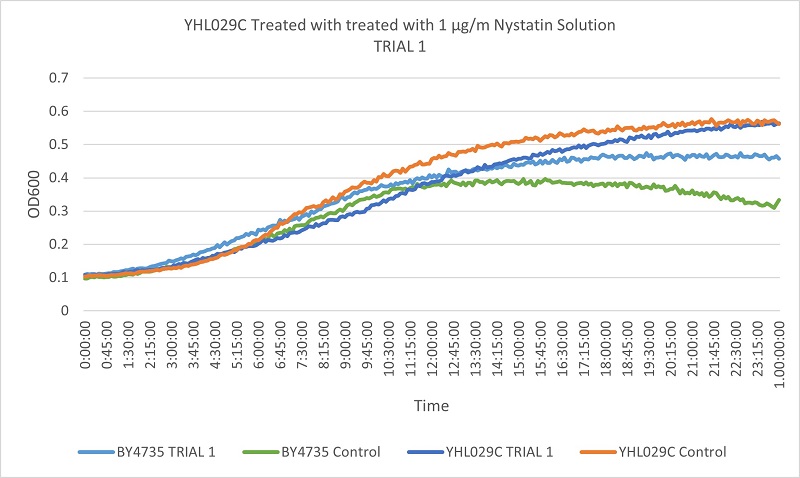
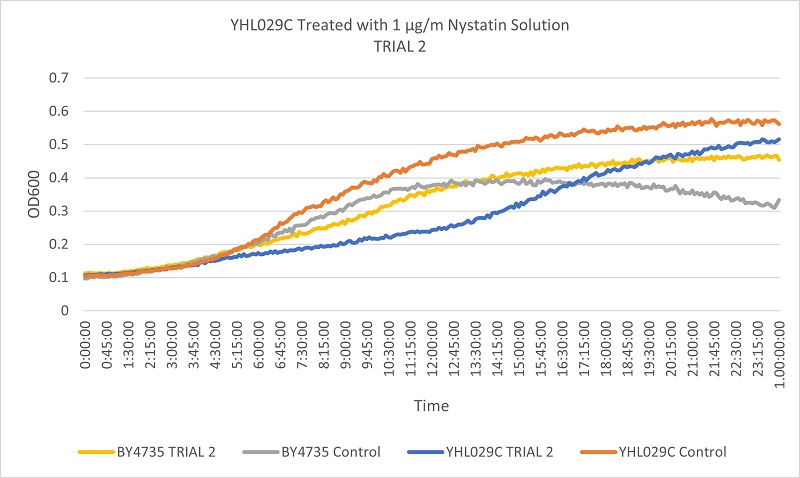 From the growth curve, we can see that the YHL029C control grows at a higher rate than the wild type control and experimental, but the treated YHL029C grows at a lower rate than the wild type yeast, meaning that the removal of the YHL029C gene lowers resistance to Nystatin.
From the growth curve, we can see that the YHL029C control grows at a higher rate than the wild type control and experimental, but the treated YHL029C grows at a lower rate than the wild type yeast, meaning that the removal of the YHL029C gene lowers resistance to Nystatin.
UW-Stout/Formamide SP22
Results
- 3% formamide line graph: x-axis= growing time (min); y-axis= optical density 600
- Trial 2 line graph: x-axis= growing time (min); y-axis= optical density 600; key= yeast strains and corresponding color to the individual lines in the line graph
- Average doubling time bar graph: x-axis= yeast strains and corresponding colors to the trial 2 line graph; y-axis= average doubling time (min)
Interpretation
The wild yeast cell treated with 3% formamide had a doubling time of 876.69 min. The 3% formamide solution added to nine transformed yeast cells was then compared to the wild yeast cell using the computed doubling times to see the effects of the formamide. In the experiment, some of the transformed yeast cells were heavily effected by the formamide, including the YHL029C strain. The YHL029C strain had doubling times significantly faster than the wild yeast cell, with the fastest doubling time of 566.06 min. It can be concluded that the transformed yeast cell, YHL029C, had a unique response to the formamide stress test used in the experiment.
References
See Help:References on how to add references
- ↑ Huh WK, et al. (2003) Global analysis of protein localization in budding yeast. Nature 425(6959):686-91 SGD PMID 14562095
- ↑ Kushner DB, et al. (2003) Systematic, genome-wide identification of host genes affecting replication of a positive-strand RNA virus. Proc Natl Acad Sci U S A 100(26):15764-9 SGD PMID 14671320
See Help:Categories on how to add the wiki page for this gene to a Category </protect>
UW-Stout/Nonionic Detergent SP22
As part of the University of Wisconsin Stout Orphan Gene Project this gene was tested by exposing the cells to 0.001% concentrated NLS. (Nonionic detergent)
Interpretations:
-According to the graph above, we can see that the KO yeast cell YHL029C follow a smaller sensitivity to the stress than the Wild type strain.
-The KO with NLS peaks a lot later than the KO w/o NLS
-We can then conclude that the knocked-out gene in YHL029C doesn't have a significant impact on the growth of the yeast cell.
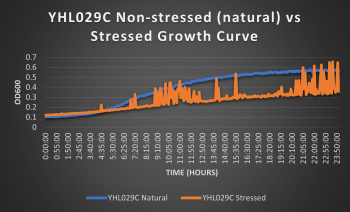 Knocked out gene seems to have some effect on cell growth in pH 7 environment based on the flattening of the growth curve. Spikes in stressed line are to be ignored; they occurred due to clumping of cells during analysis. We are focusing on the general linear trend of the growth curve. Please see protocol for specific quantitative doubling time results.
Knocked out gene seems to have some effect on cell growth in pH 7 environment based on the flattening of the growth curve. Spikes in stressed line are to be ignored; they occurred due to clumping of cells during analysis. We are focusing on the general linear trend of the growth curve. Please see protocol for specific quantitative doubling time results.
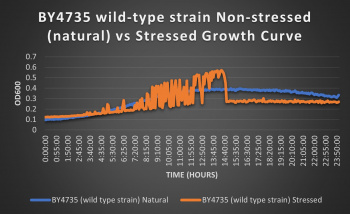 The wild-type strain was used as a control in this experiment; no genes were knocked out, it just represents how the experiment ran on the knocked-out gene strains affects a "typical" cell growth curve. Inclusion of this data on each knock-out strain growth curve graph made for difficult interpretation, so it has been separated. Please refer to this graph as a control when viewing the knock-out strain growth curve graph. Spikes in stressed line are to be ignored; they occurred due to clumping of cells during analysis. We are focusing on the general linear trend of the growth curve.
The wild-type strain was used as a control in this experiment; no genes were knocked out, it just represents how the experiment ran on the knocked-out gene strains affects a "typical" cell growth curve. Inclusion of this data on each knock-out strain growth curve graph made for difficult interpretation, so it has been separated. Please refer to this graph as a control when viewing the knock-out strain growth curve graph. Spikes in stressed line are to be ignored; they occurred due to clumping of cells during analysis. We are focusing on the general linear trend of the growth curve.
